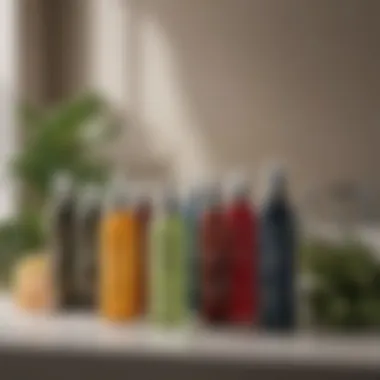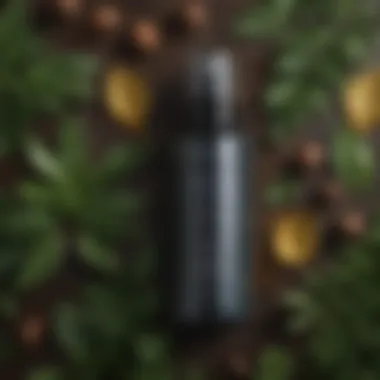Ultimate Guide to Leave-In Sprays: Top Picks & Benefits


Intro
Leave-in sprays have become essential components in the haircare routine of many individuals, offering not just convenience, but also versatility. They enable users to maintain healthy hair while providing styling options that suit their lifestyle. The wide variety of leave-in products on the market caters to distinct hair types. Understanding these differences is crucial for selecting the right one.
This article explores the features, benefits, and some recommended products that elevate the haircare experience. By diving into the functionality of leave-in sprays, one can better appreciate both how they work and why certain formulations may be more beneficial for specific hair needs.
The following sections will cover a range of topics designed to help readers make informed choices when it comes to their haircare regimen.
Prelude to Leave-In Sprays
Leave-in sprays have become essential in modern hair care routines. They serve a unique purpose, providing various benefits tailored to individual hair needs. Understanding the significance of leave-in sprays is crucial for anyone looking to improve their hair health and manageability.
Definition and Purpose
Leave-in sprays are products designed to be applied to hair after washing and conditioning, without the need for rinsing. Their primary purpose is to offer moisture, conditioning, and protection. Unlike rinse-out conditioners, these sprays remain in the hair, delivering ongoing hydration and nutrients throughout the day. They can help smooth frizz, detangle strands, and enhance shine, making hair easier to style.
The selection of leave-in sprays varies broadly, targeting different hair types and concerns. For instance, a leave-in spray for dry hair typically includes ingredients rich in moisture, such as aloe vera or coconut oil. On the other hand, some sprays are formulated specifically for curly hair, aiming to define curls and reduce breakage. Thus, understanding their specific purposes helps in choosing the right product to meet individual hair needs.
Historical Context
The origin of leave-in conditioners can be traced back several decades. Initially, hair care products focused mostly on traditional shampoos and rinse-out conditioners. The concept of leave-in sprays evolved as consumers began demanding more versatile options for hair care. This shift occurred alongside a growing awareness of the difference in hair textures and the need for specialized treatments.
Over the years, these products have expanded to include a range of formulations. Many brands have recognized the diverse nature of hair and tailored their leave-in sprays to address a plethora of issues. As a result, leave-in sprays have established their place as a fundamental component of hair care routines. This evolution reflects an increasingly sophisticated understanding of hair health and maintenance, catering to the unique needs of various hair types.
"Understanding leave-in sprays can empower individuals to make informed choices that enhance their hair's vitality and overall appearance."
Overall, the study and application of leave-in sprays represent an important intersection of beauty science and personal care, allowing women of all ages to achieve their desired hair goals. As we explore this topic further, it becomes evident that the right leave-in spray can reveal significant improvements in hair texture, strength, and manageability.
Understanding Hair Types and Needs
Understanding hair types and needs is essential when selecting the right leave-in spray. Each hair type has its unique characteristics and requirements. Knowing these elements can significantly influence the effectiveness of the product chosen. For instance, using a leave-in spray formulated for curly hair on straight hair may not provide the desired results. Conversely, using a spray intended for dry hair on oily hair can lead to excessive greasiness.
By identifying hair types, individuals can select products that enhance their natural texture, provide adequate moisture, and address specific concerns. This understanding also helps in preventing damage and maintaining healthy hair.
Identifying Your Hair Type
Identifying your hair type involves examining several key factors. Firstly, consider the texture—hair can be straight, wavy, curly, or coily. Each type behaves differently and may require distinct care. Secondly, thickness or density plays a role, with fine, medium, and thick classifications present. Fine hair is usually more delicate and may benefit from lighter leave-in formulas, while thick hair often needs heavier creams or oils for effective hydration.
Other considerations include porosity, which refers to how well hair absorbs moisture. Low-porosity hair resists moisture penetration, meaning lighter products are ideal. High-porosity hair tends to absorb moisture easily but also loses it quickly, so heavier moisturizing products may be necessary. Determining your hair type can take some experimentation, but it is key to finding the most suitable leave-in spray.
Common Hair Concerns
Understanding common hair concerns can further refine product selection. Many individuals experience dryness, which can arise from environmental factors, heat styling, or color treatments. A proper leave-in spray can help restore moisture and revive the hair's appearance.
Another prevalent issue is frizz. Humidity and irregular hair texture can lead to uncontrollable frizz, making specific formulas with smoothing agents essential. Damage from heat styling or chemical treatments is also a significant concern. Leave-in sprays that offer protection against thermal damage or that contain repairing ingredients are vital for those needing recovery.
Furthermore, color-treated hair can have unique needs. Color can cause hair to become dry or prone to fading. Leave-in sprays catering to color-treated hair often include UV filters or color protection ingredients, making them highly beneficial.
By understanding these common concerns, consumers can choose leave-in sprays that specifically address their needs, enhancing hair health in the long run.
The Science Behind Leave-In Sprays


Understanding the science behind leave-in sprays is essential for appreciating their role in hair care. These products have gained popularity due to their multifunctional benefits. They often provide hydration, protection, and styling versatility, making them a staple in many hair care routines. A closer look at the science reveals how specific ingredients and formulations impact hair health and manageability.
Key Ingredients
The effectiveness of leave-in sprays largely depends on their ingredient profiles. Here are some common ingredients found in these products:
- Water: This is the base of many leave-in sprays, providing moisture needed for hydration.
- Humectants: Ingredients like glycerin attract moisture from the air to the hair, helping to keep it hydrated throughout the day.
- Proteins: Hydrolyzed wheat or silk proteins can strengthen the hair shaft, improving its overall structure and elasticity.
- Oils: Natural oils, such as argan, jojoba, or coconut oil, add shine and moisture while helping to seal the hair cuticle.
- Polymers: These help provide hold and control, making styling easier and more effective.
Each of these ingredients has specific roles that contribute to the overall performance of leave-in sprays. Knowing what is inside the product can help consumers make informed decisions tailored to their hair needs.
How Leave-In Sprays Work
Leave-in sprays work through a combination of moisturization, coating, and protection. Here’s how:
- Moisturization: When applied, the water and humectants penetrate the hair shaft, delivering moisture and preventing dryness. This hydration is crucial for maintaining healthy hair, especially in arid environments.
- Coating: Oils and polymers form a lightweight barrier around each hair strand. This protects against environmental factors like UV rays and pollution, reducing damage over time.
- Detangling and Styling: The formulation of many leave-in sprays includes conditioning agents that help prevent knots and tangles. Consequently, this makes hair easier to comb and style.
- Protection from Heat: Some leave-in sprays include heat protective agents that shield hair from the damaging effects of heat-styling tools.
Benefits of Using Leave-In Sprays
Leave-in sprays have gained significant traction in the hair care industry for their versatile functionalities and benefits. Women of all ages can find value in these treatments. Understanding the advantages they offer can help in selecting the right spray for your hair type and needs. Key benefits include moisturization, manageability, and protection against damage, each of which contributes to the overall health and appearance of hair.
Moisturization and Hydration
One of the primary benefits of using leave-in sprays is their ability to provide essential moisturization and hydration. Many leave-in products contain ingredients like glycerin and aloe vera. These ingredients work to draw moisture into the hair, helping to prevent dryness. When hair is adequately moisturized, it appears shinier and healthier. This is particularly important for individuals with dry or frizzy hair, as they are more likely to suffer from breakage and split ends. Additionally, hydration helps to maintain elasticity, reducing the risk of damage from styling tools and environmental factors. When choosing a leave-in spray, look for those that explicitly mention the capability to hydrate and nourish the hair.
Enhanced Manageability
Managing hair can be a challenge for many. Leave-in sprays can aid significantly in this area. They help to smooth the hair cuticle, which can prevent tangling and breakage during styling. Products with detangling properties make it easier to comb through hair, especially for those with curly or textured hair. This increased manageability allows for quicker styling, ultimately giving more freedom to experiment with different looks. Users often report that they can spend less time on their hair each day due to the ease that quality leave-in sprays provide. For those struggling with frizz or flyaways, a good leave-in spray can serve as a protective barrier that enhances the overall finish of styled hair.
Protection Against Damage
Another critical aspect of leave-in sprays is their protective qualities. Many leave-in sprays include ingredients that help shield hair from environmental stressors such as UV rays, pollution, and heat from styling tools. This is particularly essential for those who frequently use blow dryers or curling irons. A leave-in spray that doubles as a heat protectant can significantly minimize the potential for heat-related damage. It forms a protective layer over the hair shaft, which can prevent moisture loss and shield against harmful external factors. By incorporating a leave-in spray into your hair care routine, you can enhance your hair's resilience and longevity, making it less prone to damage and breakage over time.
In summary, leave-in sprays offer various benefits that can improve both the condition and the manageability of hair. With options available for all hair types, these products are invaluable in achieving healthy hair while minimizing damage.
How to Choose the Best Leave-In Spray
Selecting the right leave-in spray is essential for achieving optimal hair health. With diverse products available, understanding their features can guide your choices effectively. This section focuses on key elements such as ingredient assessment and matching the product to your specific hair type. By making informed decisions, you can enhance your hair's manageability and protect it against damage.
Assessing Ingredients and Formulas
When choosing a leave-in spray, evaluating the ingredients is paramount. Each component plays a role, impacting your hair's health positively or negatively. Products may contain a variety of ingredients. Common components include silicones, proteins, and natural extracts. Silicones can smooth and protect hair, offering a shiny appearance. Proteins help strengthen strands, particularly useful for damaged hair. On the other hand, natural extracts from oils or botanicals can provide moisture and nourishment.
Here are some key ingredients to look for:
- Hydrating agents like glycerin or aloe vera, which enhance moisture retention.
- Nourishing oils such as argan oil or coconut oil, known for their deep conditioning properties.
- Heat protectants like dimethicone protect the hair from styling tools.
- UV filters to shield hair from sun damage.
Consider formulations tailored to your needs. For example, if your hair tends to be oily, look for a lightweight formula. In contrast, dry hair may benefit from a richer, more moisturizing product.
Matching to Your Hair Type
Understanding your hair type is critical in selecting the right leave-in spray. Different hair types have unique requirements, and a product that works for one may not be suitable for another. To find a good match, first identify whether your hair is straight, wavy, curly, or coily. Each type responds differently to various formulations.
- Straight hair often requires lightweight sprays that add shine without weighing it down.
- For wavy hair, look for sprays that enhance waves without frizzing them.
- Curly hair generally benefits from products that offer extra moisture and definition.
- Coily hair can be hydrated deeply, so rich, creamy leave-in conditioners are ideal.


Beyond texture, consider other factors like porosity. High-porosity hair, which absorbs moisture easily, often needs heavier products to retain hydration. Conversely, low-porosity hair may require lighter formulas to avoid buildup.
In summary, the key to successful leave-in spray selection lies in analyzing ingredients and matching the product to your hair type. Armed with this knowledge, you can make better choices that promote healthier, more manageable hair.
"Choosing the right leave-in spray can transform your hair care routine, leading to improved texture and appearance."
Top Recommendations for Leave-In Sprays
When exploring leave-in sprays, understanding which products stand out from the masses is crucial. The right product can significantly influence not only the appearance of your hair but also its overall health. This section will delve into tailored recommendations for various hair types. Each recommendation considers specific needs, such as moisture retention, curl definition, and protection for chemically treated hair. By focusing on these key factors, readers can make informed choices based on their hair care requirements.
Best for Dry Hair
For individuals with dry hair, a leave-in spray needs to deliver intense hydration and nourishment. A product rich in emollients and humectants can help alleviate dryness by locking in moisture.
Recommended Options:
One effective leave-in spray for dry hair is the SheaMoisture Jamaican Black Castor Oil Leave-In Conditioner. Formulated with shea butter and Jamaican black castor oil, it provides deep moisture and promotes elasticity. Another excellent choice is the Cantu Shea Butter Leave-In Conditioning Repair Cream, which also emphasizes strengthening and moisturizing properties.
Best for Curly Hair
Curly hair has specific needs, such as frizz control, definition, and added moisture. For this hair type, a leave-in spray that enhances curl structure and reduces frizz is essential.
Recommended Options:
The Ouidad Moisture Lock Leave-In Conditioner works astonishingly well for maintaining hydration in curly hair. It delivers long-lasting moisture while improving curl definition. Another notable product is the DevaCurl Leave-In Decadence; this option provides extra moisture and defines curls without weighing them down.
Best for Color-Treated Hair
Color-treated hair requires products that not only maintain color vibrancy but also provide protection from damage caused by chemical processing. A leave-in spray for this hair type should ideally contain ingredients that shield against UV rays and environmental factors that lead to color fading.
Recommended Options:
Consider the Pureology Color Fanatic Leave-In Treatment which is specifically designed to address the needs of color-treated hair. It offers broad-spectrum UV protection while providing 21 essential benefits. Another strong contender is the Joico Color Balance Purple Leave-In Treatment, especially beneficial for blonde or silver hair, as it helps neutralize brassiness while maintaining moisture levels.
Choosing the right leave-in spray can redefine hair care routines, making it easier to style and manage hair effectively for various needs.
Application Techniques for Leave-In Sprays
Using leave-in sprays effectively can significantly enhance their benefits. The proper application technique maximizes product efficiency, ensuring that your hair gets the nourishment it needs without overwhelming it with product. Understanding how to use these sprays will lead to improving manageability, promoting health, and providing the desired styling results.
Prepping Your Hair
Getting your hair ready for leave-in spray is crucial. The first step is to start with clean hair. Using a mild shampoo and a suitable conditioner will ensure any product build-up is removed. When your hair is free from dirt or oils, it can better absorb the leave-in spray. After washing, gently towel-dry your hair to remove excess moisture.
Damp hair is ideal for applying leave-in sprays. This condition helps the product penetrate the hair shaft more thoroughly, ensuring better hydration and manageability. If your hair is too wet, it may dilute the spray's effectiveness, while dry hair may not absorb the product well.
After towel-drying, consider detangling your hair with a wide-tooth comb. This process helps distribute the leave-in spray more evenly and prevents breakage. Once your hair is prepped, you are ready to apply the leave-in spray.
Best Practices for Application
When applying leave-in spray, technique matters. Here are some best practices to follow:
- Distance Matters: Hold the spray about 8-12 inches away from your hair. This distance helps to avoid product concentration in one area, leading to even distribution.
- Sectioning: Divide your hair into sections. This method allows better coverage and ensures every strand gets the product.
- Spraying Technique: Start by spraying from the mid-lengths of your hair down to the ends. These areas are usually drier and benefit most from additional moisture. Spraying at the roots can weigh down your hair, making it look greasy.
- Use Your Hands: After spraying, run your fingers through your hair. This step helps to distribute the product evenly. You can also use a comb if you prefer.
- Avoid Overuse: Less is often more. Start with a small amount, and you can always add more if needed. Using too much leave-in spray can make your hair feel heavy or sticky.
- Style As Desired: Once applied, your hair can be styled as desired. You can blow-dry, air-dry, or simply leave it to dry naturally, depending on your preference.
Applying leave-in spray correctly enhances both its efficacy and your styling options.
Maintaining proper application techniques will ensure that you get the maximum benefits from your leave-in spray. This disciplined approach leads to healthier hair, making it manageable and easy to style.
Potential Drawbacks of Leave-In Sprays


In discussing leave-in sprays, it is essential to address their potential drawbacks. While these products can provide considerable benefits to hair health and styling, they carry specific issues that users should consider. A comprehensive understanding of these drawbacks enables informed decision-making about hair care practices. Below, we explore two key issues associated with leave-in sprays: potential allergic reactions and product build-up.
Possible Allergic Reactions
Some individuals may experience allergic reactions to certain ingredients found in leave-in sprays. Common allergens include fragrances, preservatives, and specific botanical extracts. Symptoms of an allergic reaction may encompass redness, itching, and swelling on the scalp or surrounding areas.
To minimize risk, users should conduct a patch test before applying a new product to their entire head. This involves applying a small amount of the spray to a discreet area and monitoring for any adverse effects. Choosing hypoallergenic formulas can also help, especially for those with sensitive skin.
"Being aware of your skin's sensitivity is crucial when selecting hair products. Always read labels and consult with a dermatologist if needed."
Product Build-Up
Another notable concern with leave-in sprays is product build-up. Over time, the accumulation of product on hair strands can lead to a heavy and greasy appearance. This issue is particularly prevalent for individuals using multiple styling products or applying leave-in sprays daily without adequate cleansing.
To mitigate the effects of build-up, it is important to wash hair regularly with a clarifying shampoo. This helps remove residue and restore hair's natural texture and shine. Additionally, alternating between leave-in sprays and lighter formulations can also lessen the likelihood of build-up, ensuring that the hair remains healthy and manageable.
Ultimately, understanding these drawbacks is a vital part of effectively incorporating leave-in sprays into one's hair care routine. Recognizing these aspects can assist users in making better choices that align with their specific hair type and needs.
Leave-In Sprays and Sustainable Haircare
Sustainable haircare is an increasingly significant topic in the beauty industry. The environmental impacts of cosmetic products have prompted both consumers and brands to rethink their approaches. Leave-in sprays, while beneficial for hair health, can also contribute to ecological concerns if not chosen wisely.
When evaluating leave-in sprays, one must consider the materials used in packaging, the sourcing of ingredients, and the overall impact on the ecosystem. By opting for leave-in sprays that prioritize sustainability, consumers can make choices that align with their values, promoting a healthier planet while enjoying the benefits for their hair.
The importance of this topic cannot be overstated. As awareness grows around issues like plastic waste and harmful chemicals, brands that manage to blend efficacy with sustainability can distinguish themselves.
Eco-Friendly Brands
Today, there are several brands that stand out for their commitment to eco-friendly practices. These brands focus on producing leave-in sprays that not only perform well but also minimize environmental harm. They often utilize recyclable packaging and emphasize biodegradable formulations.
A few notable eco-friendly brands in this category include:
- Burt's Bees: Known for their natural approach, they create products that harness the power of nature with minimal environmental footprint.
- Moroccanoil: Offers a range of products that emphasize the use of sustainable and responsible ingredients.
- Aveda: Focuses on plant-based ingredients and ensures that their formulations are environmentally friendly.
Choosing products from such brands means opting for solutions that consider both personal hair health and the well-being of the planet.
Sustainable Ingredient Sourcing
The sourcing of ingredients is a critical aspect of sustainable haircare. Brands that prioritize sustainability often seek ingredients that are responsibly sourced. This includes not harming ecosystems or exploiting workers in the process.
Key factors in sustainable ingredient sourcing include:
- Transparency: Brands should openly communicate where and how ingredients are sourced.
- Ethically Harvested: Ingredients should be gathered in a manner that does not deplete resources or damage habitats.
- Organic Certification: Choosing organic ingredients reduces the need for chemicals, benefiting both hair health and the environment.
These practices not only support environmental integrity but also promote a holistic approach to beauty. Consumers who are aware of these factors can make educated choices that contribute to a better ecological footprint while caring for their hair.
By prioritizing sustainable options, we can foster a beauty industry that respects both individual health and environmental concerns.
The End
The conclusion of this article serves as a vital component that synthesizes the essential themes and insights surrounding leave-in sprays. Understanding their role not only enhances our daily haircare routines but also contributes to long-term hair health. Leave-in sprays offer solutions tailored to varied hair types, addressing specific concerns such as hydration, manageability, and protection. This exploration emphasizes the importance of choosing the right product that aligns with individual hair needs and preferences.
Recap of Key Points
- Definition and Purpose: Leave-in sprays are designed to provide lasting benefits beyond the initial application. They offer moisture, protection, and styling support for numerous hair types.
- Benefits: Using these sprays can result in improved hair hydration, manageability, and increased protection against environmental stressors like UV rays and pollution.
- Application Techniques: Proper application is crucial. Strategies include preparing hair correctly before application and using best practices to maximize product effectiveness.
- Sustainable Practices: A growing concern in haircare is sustainability. Many brands are adopting eco-friendly practices, making it easy for consumers to make informed choices.
This recap highlights that selecting the right leave-in spray is not just about personal preference but also about understanding the underlying hair needs.
Final Recommendations
In summation, when choosing a leave-in spray, consider the specific qualities of your hair. If your hair is dry, products with nourishing oils can be beneficial. For curly hair, look for sprays that enhance curl definition without weighing them down. Color-treated hair demands products that protect color and provide moisture. Furthermore, always pay attention to ingredient lists to avoid products that may cause allergic reactions or build-up.







